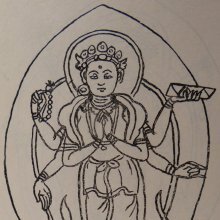Varadayaka, Varadāyaka, Vara-dayaka: 3 definitions
Introduction:
Varadayaka means something in Buddhism, Pali, Hinduism, Sanskrit. If you want to know the exact meaning, history, etymology or English translation of this term then check out the descriptions on this page. Add your comment or reference to a book if you want to contribute to this summary article.
Images (photo gallery)
In Hinduism
Purana and Itihasa (epic history)
Source: archive.org: Shiva Purana - English TranslationVaradāyaka (वरदायक) refers to the “bestower of boons”, according to the Śivapurāṇa 2.3.42 (“Description of the meeting of the Lord and the Mountain”).—Accordingly, as Brahmā narrated to Nārada: “[...] Seeing Śiva in front, Himavat bowed to Him. [...] He looked benevolent to the people. Being one He had assumed different physical bodies for his own reasons. He was Brahman itself, the lord of all and the bestower of boons (varadāyaka). He was both with or without attributes, subservient to the devotees, merciful, greater than primordial Being and primordial nature, Existence, Knowledge and Bliss itself. [...]”.

The Purana (पुराण, purāṇas) refers to Sanskrit literature preserving ancient India’s vast cultural history, including historical legends, religious ceremonies, various arts and sciences. The eighteen mahapuranas total over 400,000 shlokas (metrical couplets) and date to at least several centuries BCE.
In Buddhism
Tibetan Buddhism (Vajrayana or tantric Buddhism)
Source: archive.org: The Indian Buddhist IconographyVaradāyaka (वरदायक) or Varadāyakalokeśvara refers to number 11 of the 108 forms of Avalokiteśvara found in the Machhandar Vahal (Kathmanu, Nepal). [Machhandar or Machandar is another name for for Matsyendra.].
Accordingly,—
“Varadāyaka is one-faced and six-armed and stands on a lotus. The two principal hands join against his chest in forming the Añjali. He shows also the rosary and the Varada pose in the two right hands, and the book and a mudrā (probably Karaṇa ?) in the two left”.
The names of the 108 deities [viz., Varadāyaka] possbily originate from a Tantra included in the Kagyur which is named “the 108 names of Avalokiteshvara”, however it is not yet certain that this is the source for the Nepali descriptions. Tibetan Buddhism includes schools such as Nyingma, Kadampa, Kagyu and Gelug. Their primary canon of literature is divided in two broad categories: The Kangyur, which consists of Buddha’s words, and the Tengyur, which includes commentaries from various sources. Esotericism and tantra techniques (vajrayāna) are collected indepently.
Languages of India and abroad
Sanskrit dictionary
Source: Cologne Digital Sanskrit Dictionaries: Monier-Williams Sanskrit-English DictionaryVaradāyaka (वरदायक):—[=vara-dāyaka] [from vara] m. a [particular] Samādhi, [Kāraṇḍa-vyūha]
Sanskrit, also spelled संस्कृतम् (saṃskṛtam), is an ancient language of India commonly seen as the grandmother of the Indo-European language family (even English!). Closely allied with Prakrit and Pali, Sanskrit is more exhaustive in both grammar and terms and has the most extensive collection of literature in the world, greatly surpassing its sister-languages Greek and Latin.
See also (Relevant definitions)
Partial matches: Dayaka, Vara.
Starts with: Varadayakalokeshvara.
Ends with: Sadavaradayaka, Tuvaradayaka.
Full-text: Sadavaradayaka, Varadayakalokeshvara, Trilokasandarshana.
Relevant text
Search found 2 books and stories containing Varadayaka, Vara-dayaka, Vara-dāyaka, Varadāyaka; (plurals include: Varadayakas, dayakas, dāyakas, Varadāyakas). You can also click to the full overview containing English textual excerpts. Below are direct links for the most relevant articles:
The Indian Buddhist Iconography (by Benoytosh Bhattachacharyya)
108 forms of Avalokiteśvara (11): Varadāyaka Lokeśvara
108 forms of Avalokiteśvara (19): Trilokasandarśana Lokeśvara
Betwixt Thee and Us < [April – June, 2008]

